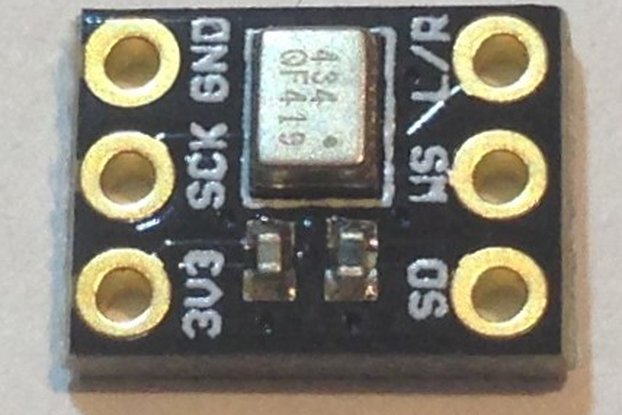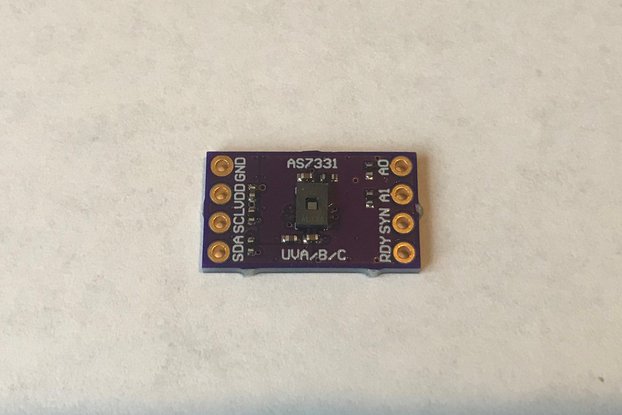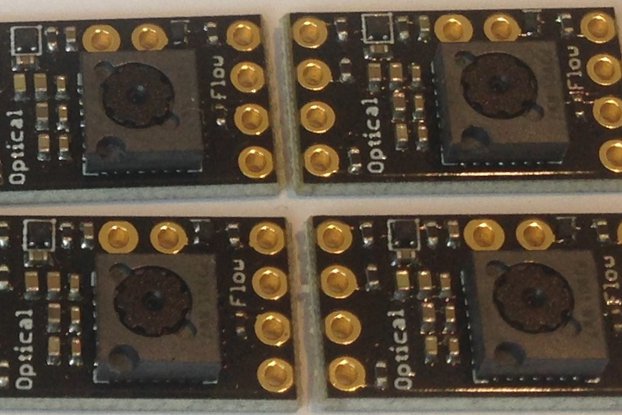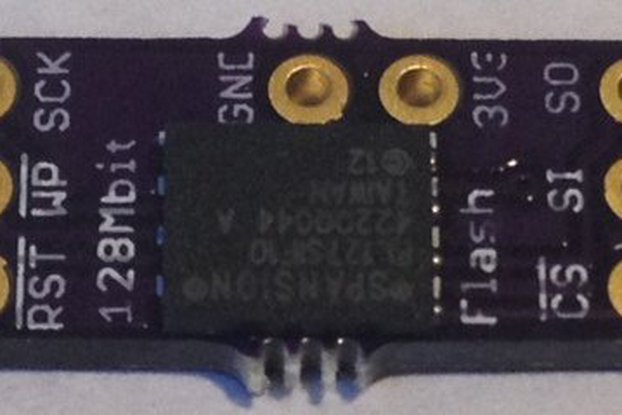Small breakout for ST's VL53L5CX 8 x 8 pixel ranging camera
Designed by Pesky Products in United States of America
Buy with confidence.
Our Tindie Guarantee protects your purchase from fraud. Learn More
Back in stock! What is it? This is a 17.9 mm x 10.3 mm breakout board for ST's VL53L5CX ranging camera. Excerpting from ST's product page: "VL53L5CX is a state of the art, time-of-flight (ToF), laser…
Read More…Back in stock!
This is a 17.9 mm x 10.3 mm breakout board for ST's VL53L5CX ranging camera.
Excerpting from ST's product page:
"VL53L5CX is a state of the art, time-of-flight (ToF), laser-ranging sensor .... Unlike conventional IR sensors, the VL53L5CX uses ST's latest generation, direct ToF technology, which allows absolute distance measurement whatever the target color and reflectance. It provides accurate ranging up to 400 cm and can work at fast speeds (60 Hz), which makes it the fastest, multizone, miniature ToF sensor currently on the market. ... Multizone distance measurements are possible up to 8x8 zones with a wide 61° diagonal FoV that can be reduced by software." (emphasis mine)
The VL53L5CX maintains the accuracy (typically ~1%), independence on target surface reflectance, and the long 400 cm ranging capabilities of the previous generation VL53L1 and VL53L3 time-of-flight ranging sensors. The VL53L5CX improves on these by allowing 1) up to 64 separate ROIs (regions of interest) compared to up to 16 in the VL53L1 and 2) a wide 61° field of view compared to 27° for the VL53L1 and 25° for the VL53L3.
The 64 ROIs means the VL53L5CX can serve as a low-resolution ranging camera (4 x 4 pixels or 8 x 8 pixels) allowing a variety of applications from gesture recognition (up/down/left/right) to pose estimation (sitting/standing/prone) to object detection (cup or glass, etc) all while preserving personal privacy; there simply isn't enough resolution to identify people. Furthermore, the wide 61° field of view means a full 360 degrees can be covered with just 6 sensors making collision avoidance for rolling or flying robots much cheaper and easier.
Like all VL53LX sensors, several can be ganged on the same I2C bus (SPI not supported for the VL53L5CX except with custom firmware, ask ST) since the I2C address can be changed via software control from the host. ST provides a comprehensive C-based driver library for the VL53L5CX which Simon Levy has turned into an Arduino-compatible library for easy integration of the VL53L5CX with just about any microcontroller. I also have some examples reposited here.
The breakout has 0.1"-pitch edge through holes and is designed to be mounted onto a breadboard with pin headers or is small enough to be integrated into your existing project using wires, etc. Don't forget to peel off the protective Kapton film on top of the VL53L5CX sensor before using in your project.
The board exposes VDD and GND (3V3 or 2V8 since AVDD and IOVDD are tied together on this breakout) as well as the I2C bus SDA and SCL with 2K2 pullups on the board. INT is an open-drain interrupt pulled up to VDD by a 47 kOhm resistor (active LOW, so triggered on FALLING edge). So far, this is all straightforward and is probably as much as most users will need to bother with.
LPN-->LOW disables VL53L5CX I2C communications to allow the I2C address of some other, LPN-enabled VL53L5CX to be changed via I2C command when there are two or more VL53L5CX on the I2C bus (active LOW, pulled up by a 47 kOhm resistor and the same function as XSHUT on the VL53L0/1).
RST is the I2C interface reset pin (pulled to GND with a 47 kOhm resistor and active HIGH). This pin enables I2C or SPI, but since SPI is not supported in the stock firmware the effect of toggling RST HIGH then LOW is to reset the I2C interface. There is likely no need to connect this pin.
IO2 is pulled HIGH with a 47 kOhm resistor like INT but has, as yet, no function though future firmware might allow enabling IO2 as a second interrupt. For now, no need to connect this pin either.
Speaking of interrupts, the exposed interrupt can be used to signal data ready to the MCU. But here is where it gets freaky cool. The VL53L5CX can also be programmed to interrupt on range threshold individually, per pixel! In other words, when a pixel or group of pixels crosses the user-programmed range threshold, the interrupt triggers and the status register provides the specific pixel or group of pixels that caused the trigger.
Furthermore, the VL53L5CX can be programmed to automatically perform basic optical flow measurements by comparing sequential frames of data with an output of "motion intensity" per pixel. This is essentially a relative velocity field.
The VL53L5CX outputs a lot of useful information in addition to range and motion intensity such as range error estimation, target reflectance, and number of targets in the field of view, etc.
The VL53L5CX firmware by default enables all features provided in the firmware which can require many kBytes of SRAM to store all of the data arrays, etc. The user can customize the firmware by disabling one or more features that will not be used to save power and, more importantly, MCU memory. Consult the VL53L5CX User's Guide for the details.
And be aware that there are limitations on maximum range that depend on the lighting conditions (dark vs 5 klux), frame rate chosen (15 or 60 Hz) and pixel groups used (inner or corner), etc so read the VL53L5CX data sheet and User's Guide to make sure you understand what this sensor can and cannot do.
However, there is no limitation to the amount of fun you can have using this sensor breakout board!
I love sensors and can't help but test the latest ones. This is especially true for position and motion sensors.
I have been using ST's time-of-flight (ToF) ranging sensors for a variety of gesture and ranging applications ever since the ~10-cm-ranging VL6180X was first introduced five years ago. With each new ToF sensor the product gets better and better. First, up to 200 cm ranging for the VL53L0, then multiple ROIs and up to 400 cm ranging for the VL53L1, finally the 500 cm range of the VL53L3. It's simple, cheap, and accurate technology that keeps getting better!
The VL53L5CX takes the accurate-long-ranging, multiple-ROI concept to the next level. Up to 64 pixels of accurate 100 - 400 cm ranging data spread over a 60 degree field of view. This turns the VL53L5CX into a ranging camera with a whole new spectrum of applications limited only by your imagination.
This is a small, easy to use breakout that makes it simple to integrate the VL53L5CX with your MCU and project.
The ST C-based driver is integrated into an easy-to-use Arduino library providing sophisticated functionality with a few simple function calls.
This breakout costs about the same as the ST satellite board but is much smaller and easier to use.
The EAGLE CAD board design is open source; copy the design for your custom pcb.
Order the pcbs from OSH Park and assemble some of your own or order the fully assembled and tested VL53L5 breakout board here and see how awesome a wide-field, 8 x 8 pixel ranging camera can be!
No country selected, please select your country to see shipping options.
No rates are available for shipping to .
Enter your email address if you'd like to be notified when VL53L5CX Ranging Camera can be shipped to you:
Thanks! We'll let you know when the seller adds shipping rates for your country.
| Shipping Rate | Tracked | Ships From | First Item | Additional Items |
|---|---|---|---|---|
|
:
|
Buy with confidence.
Our Tindie Guarantee protects your purchase from fraud. Learn More
Danville, CA, United States of America
Ships from United States of America.
180 Reviews | 5,479 Orders

$49.95
Free Shipping!

$5.95
Free Shipping!

$35.95
Free Shipping!

$35.95
Free Shipping!

$49.95
Free Shipping!

$29.95
Free Shipping!

$12.95
Free Shipping!

$19.95
Free Shipping!
By clicking Register, you confirm that you accept our Terms & Conditions
We recognize our top users by making them a Tindarian. Tindarians have access to secret & unreleased features.
We look for the most active & best members of the Tindie community, and invite them to join. There isn't a selection process or form to fill out. The only way to become a Tindarian is by being a nice & active member of the Tindie community!
